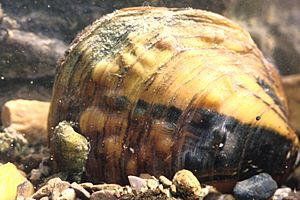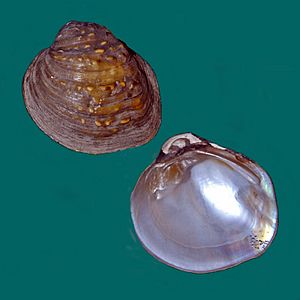Pimpleback facts for kids
Quick facts for kids Pimpleback |
|
|---|---|
 |
|
| Conservation status | |
| Scientific classification | |
| Genus: |
Cyclonaias
|
| Species: |
pustulosa
|
| Synonyms | |
|
|
The Cyclonaias pustulosa, often called the Wartyback Mussel, is a type of freshwater mussel. These amazing aquatic creatures are bivalve mollusks, meaning they have two shells that can open and close. They belong to a family called Unionidae, which are known as river mussels. You can find the Wartyback Mussel all over North America, where it is quite common.
For a while, this mussel was known by a different scientific name, Quadrula pustulosa. But in 2012, scientists looked closely at its DNA (its genetic code). They found that it was actually more closely related to mussels in the Rotundaria group, so its name was changed to Rotundaria pustulosa. More recently, it has been placed in the genus Cyclonaias. This shows how science is always learning new things about the natural world!
Contents
The Wartyback Mussel
The Wartyback Mussel gets its common name from the bumpy, wart-like growths on its shell. These bumps are a special feature that helps you tell it apart from other mussels. Its shell is usually rounded or oval-shaped and can be yellowish-brown to dark brown. Inside, the shell is often white or bluish-white.
Where Do Wartyback Mussels Live?
Wartyback Mussels live in freshwater environments like rivers and streams. They prefer places with a steady current and a bottom made of sand, gravel, or mud. They are found across a large part of North America, including the Great Lakes region and the southeastern United States. These mussels spend most of their lives partly buried in the riverbed, with just a small part of their shell sticking out.
What Do Mussels Eat?
Mussels are like natural water filters! They are filter feeders, which means they clean the water around them. They draw water into their bodies through a tube called an incurrent siphon. Inside, they filter out tiny bits of food, like algae, bacteria, and other small organic particles. Then, they push the cleaned water back out through another tube called an excurrent siphon. A single mussel can filter many gallons of water every day!
Why Are Mussels Important?
Freshwater mussels like the Wartyback are super important for healthy rivers and lakes. By filtering the water, they help keep it clean and clear for other animals and plants. This makes the water better for fish, insects, and even humans. Mussels also provide food for some animals, like muskrats and raccoons. They are also a good sign of how healthy a river ecosystem is. If mussels are thriving, it usually means the water quality is good.
Life Cycle of a Freshwater Mussel
The life cycle of freshwater mussels is quite unique. Unlike most animals, they need fish to complete part of their life cycle.
- Larvae: Female mussels release tiny larvae called glochidia. These glochidia are very small and cannot survive on their own for long.
- Hitchhiking on Fish: The glochidia must attach themselves to the gills or fins of a specific type of fish. They are like tiny, harmless parasites for a short time.
- Metamorphosis: While attached to the fish, the glochidia change and grow into tiny juvenile mussels. This process is called metamorphosis.
- Dropping Off: Once they are fully formed, the young mussels drop off the fish and settle onto the riverbed.
- Growing Up: They then burrow into the sand or gravel and start to grow into adult mussels, living their lives as filter feeders.
This special relationship with fish helps mussels spread to new areas and ensures their survival.



